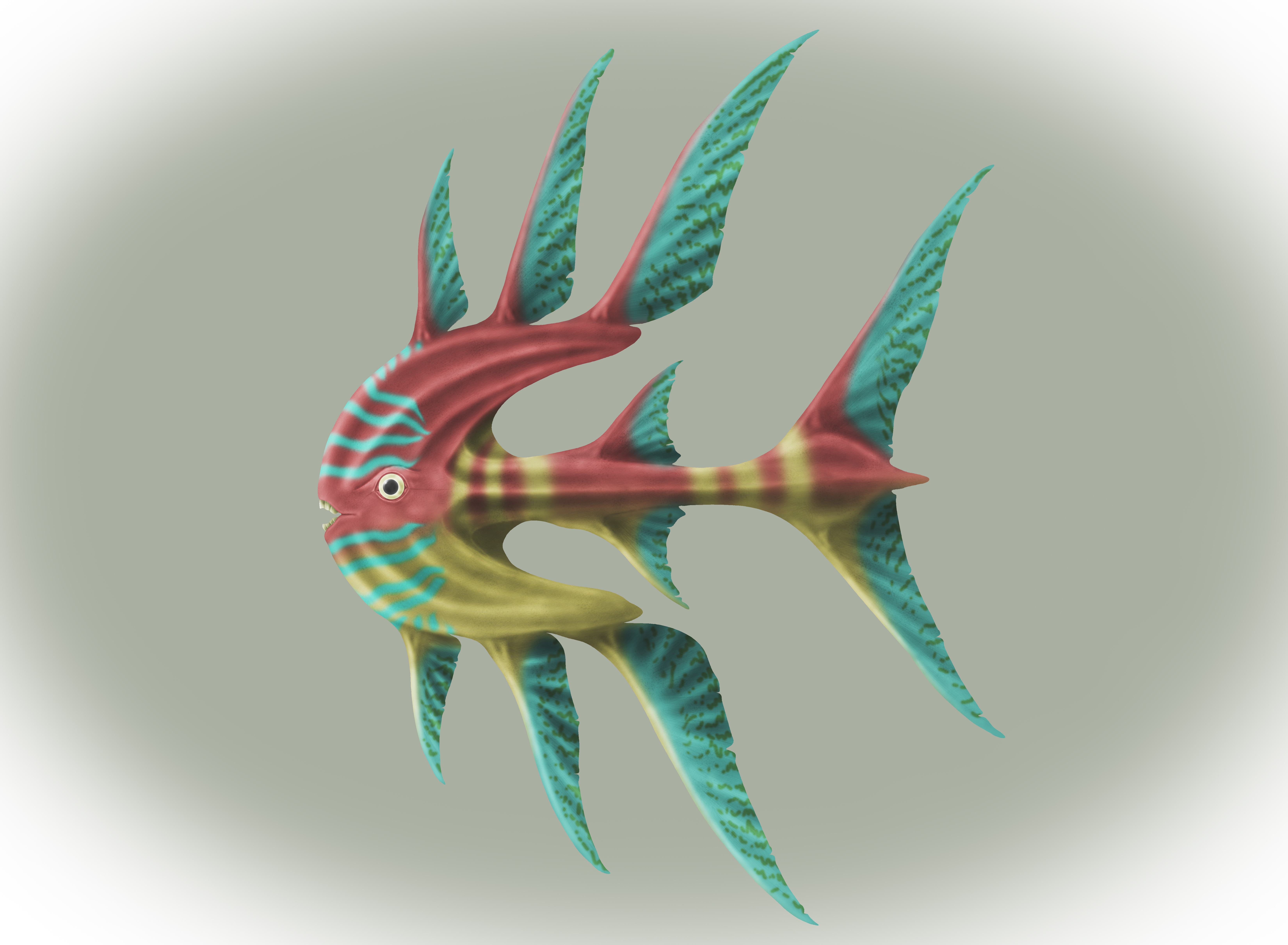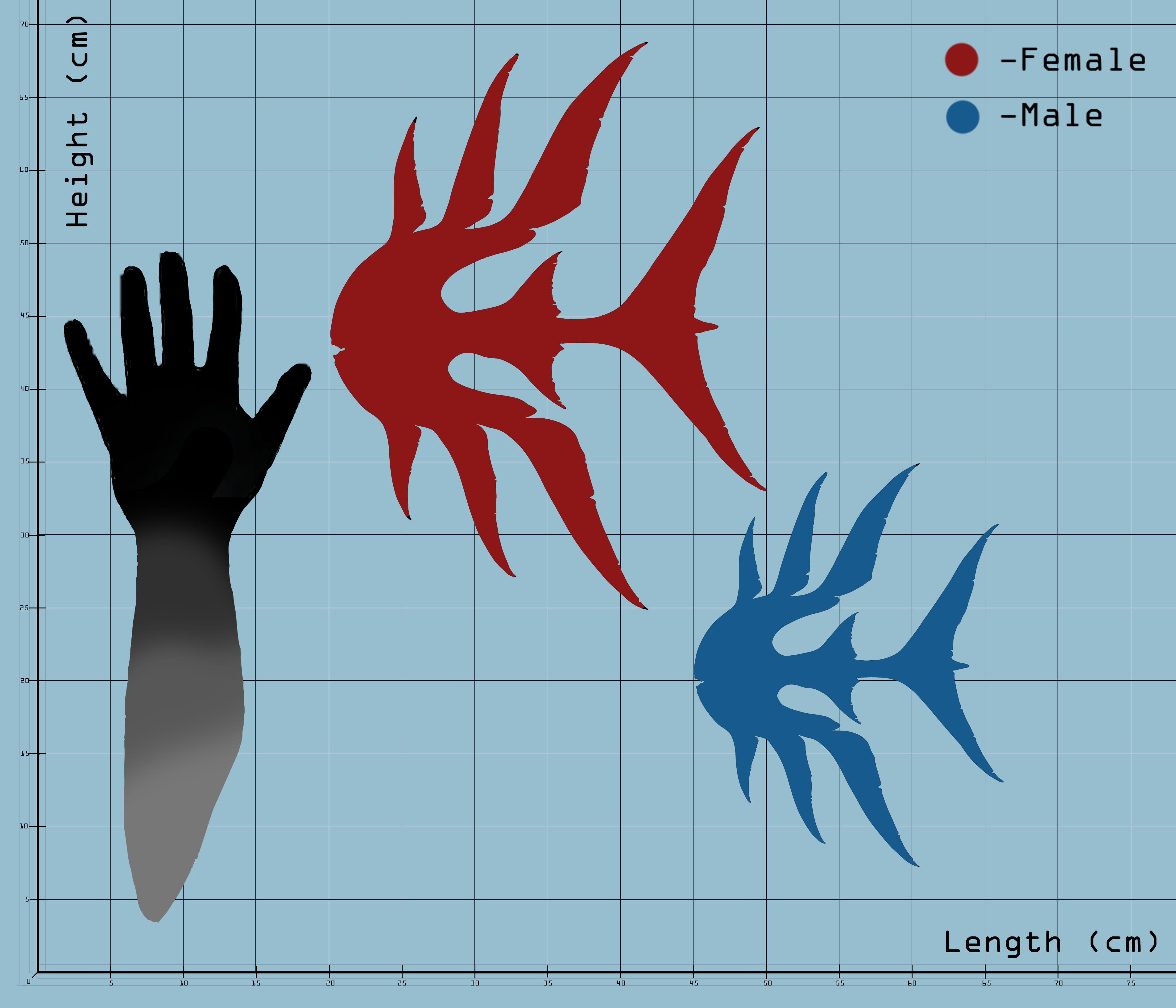Red and Yellow Frisbeefish
Anamothia fragilicaudalis is a Cyclopiscopinninid Hijerakid amphibian from the inner reefs of the Gulf Sea.
The species lives in the inner reef, in the protected area where most predators can't reach; they live in much smaller schools compared to its southern cousin, the Azure Frisbeefish, ranging from 10 to 30 pairs.
A. fragilicaudalis feeds on soft encrusting algae growing on the coral's surface, keeping the reef clean from parasitic plants; it scrapes the algae from the plant's armours using the specialized teeth, fused to create a beak-like structure.
When threatened, the animal quickly finds refuge in the under-reef, where it barely fits, in the hope of the predator being discouraged and abandoning the chase; its thin and flat body can be pressed against the sandy bottom of the under-reef, putting further distance between the animal and the predator; the species also evolved a unique technique to fool predators in thinking the fled by laying in the sand and using the fins to cover themselves in it; this technique may fool the occasional Tubercolosthomatosid but is of little help against animals with much better sight.
Like its smaller cousin, the animal is monogamous and, once a couple is formed, it will never break up, even if one member dies.
Due to the bigger size and specialized diet, this amphibian remains less popular in home aquariums, remaining only locally popular for ecotourism.
In certain towns along the east coast of the Gulf Sea, the animal is dried out and sold as a souvenir or prepared into jerky as a novelty food.
The practice has been highly criticized, however, as the unsustainable harvesting of the species could easily lead to coral reef damage.
Another reason why it's discouraged is that killing members of the group often split couples and, given their nature, this can quickly cripple their populations.
Basic Information
Anatomy
- Cranial area minimized;
- teeth fused into a beak structure.
- Spinal cords II to IV caudally oblungated.
- Gill tail ventro-dorsally restricted from cordal section II to III; gill fan long with a soft caudal drop;
- presence of Caudal fins; three Dorsal fins on the dorsal side of the body; pectoral, Anal I and Anal II all singular and ventrally disposed, presence of a fourth dorsal fin and a third anal, both veiled and subtriangular, positioned along the Gill Tail.
Genetics and Reproduction
Mandatory monogamy.
Anamothia fragilicaudalis mates in spring.
Couples are formed shortly after birth between two specimens of neighbouring shoals; a couple will mate several times a day, in-between dances and shows of affection towards one another often expressed in grooming activities and small dances and chases.
The female incubates the eggs inside the duct for ten to fifteen days before laying them in the under-reef, where they're more protected from predators.
The eggs hatch eight to seventeen days after being laid and the hatchlings will soon after joining the adults and stay in the centre of the shoal where they are most protected.
Growth Rate & Stages
Ontogeny in the species quite marked; hatchlings are born transparent to be less visible and with more rounded fins compared to the adults.
The loss of the natal aculeus happens a few minutes after birth.
Once the animal reaches maturity, the migration of the young takes place; half the newborns will leave the mother shoal in the look of neighbouring groups, in which they will find a mate; mate selection is quite long as the animal measures the possible partner thoroughly before deciding.
Once the couple is formed, it will never break up, if any of the two should die, the surviving one will never reproduce again.
Ecology and Habitats
Epipelagic species of the neritic zone, lives at depths under 20 m.
Lives in the inner reef but can be found sometimes over the reef crest, in the buttress zone.
Dietary Needs and Habits
Herbivorous species feeding on soft encrusting algae it scrapes off the coral's armours with the beak.
Biological Cycle
Periannial creature with few dips in activity year long.
Additional Information
Social Structure
In the wild they form shoals of a few dozen couples at most, layered from oldest to youngest; on the outside of the shoal there can be found the oldest specimens and the single members, in the shoal core immature and young specimens.
A few weeks after birth, half the young will leave the group in search of neighbouring ones to exchange partners with, this avoids consanguineity in the species.
Once a couple is formed they are inseparable and will partake in a series of daily activities such as passing eachother food or grooming the skin by gently scraping it with their beaks.
The animal will also communicate at short distance with small chirping noises.
In captivity it will be difficut to keep them from disbanding shoals bigger than four couples.
Domestication
Not as popular as its cousin, the Anamothia comunis, the animal still sees quite the popularity nonetheless in small groups of collectors, which enjoy building tanks dedicated to the very colourful species of the Gulf Sea.
To keep in captivity they require live corals and a stable under-reef environment, thus becoming suitable as a pet only for experienced owners.
Uses, Products & Exploitation
Of importance mainly in the tourism sector as they are sold as novelty foods, although not very palatable, or as dried out souvenirs; both of these practices quite discouraged by the TWPP (Taurian Wildlife Protection Programme).
Also of impact for ecotourism especially for snorkeling activities.
Perception and Sensory Capabilities
exquisite sight and good hearing.
Symbiotic and Parasitic organisms
Afflicted by some skin parasites they will often groom the skin to remove.
Rarely afflicted by intra-ocular parasites.
Genetic Ancestor(s)
Scientific Name
Eoichthyia; Hijerakia; Parahijerakida; Cyclopiscopinninoidea ; Cyclopiscopinninidae; Anamothia; A. fragilicaudalis
Lifespan
8 Years
Conservation Status
Least Concern: no measures underway to protect the species.
Population Trend: STABLE
Average Weight
20-80 gr
Body Tint, Colouring and Marking
Ruddy to red body with yellow to sand coloured countershading.
Three yellow bands at the base of the tail and three at the base of the Gill Fan.
Azure to neon blue stripes along the head and hammer.
Fins azure to sea foam with green striping.
Remove these ads. Join the Worldbuilders Guild












Comments